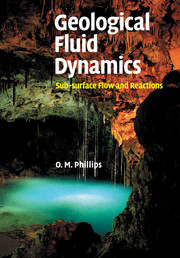5 - Patterns of reaction with flow
Published online by Cambridge University Press: 25 January 2011
Summary
Simple reaction types
A variety of chemical reactions can occur as water, carrying various dissolved chemical species, moves through a permeable matrix or a network of fissures or fractures. The nature of the resulting dissolution, precipitation, and fabric alteration depends on the reaction kinetics and the influence of temperature, pressure, and other factors on them. Their spatial distribution depends largely upon the flow. Compton and Unwin (1990) identify a series of about ten sequential steps that may be involved in any particular reaction. Of these, the controlling, or rate-limiting steps may be those in which reactants in solution are delivered from their source to the reaction site by advection and dispersion in the interstitial flow, and reaction products are carried away. Typical fluid velocities may be only 1 m/yr. In these flow-controlled reaction scenarios, there are two sets of balances to be considered: the chemical balances that operate at the molecular or ionic scale and define the nature of the reaction, and the physical balances that specify the spatial transport of dissolved reactant to the reaction site, and of fluid reaction product from it. In laboratory experiments and chemical engineering processes, the physical processes can be accelerated by stirring, but in many geochemical reactions in rock fabrics the natural transport processes can be so slow that they control the rate at which the overall reaction can proceed.
- Type
- Chapter
- Information
- Geological Fluid DynamicsSub-surface Flow and Reactions, pp. 194 - 263Publisher: Cambridge University PressPrint publication year: 2009



